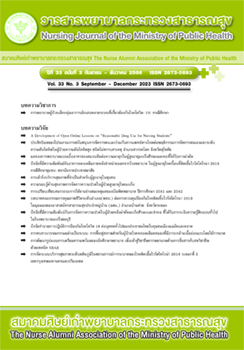Development of a Model to Prepare Nursing Students for Entry into the Nursing Professional in Interdisciplinary Communication with the SBAR Technique
Main Article Content
Abstract
The objective of this study was to develop a model to prepare nursing students to learn to communicate professionally within an interdisciplinary team using the SBAR technique. The research included 1) studying the need for readiness preparation for communication with interdisciplinary team members using the SBAR technique; 2) developing a readiness preparation model to communicate with interdisciplinary team members using the SBAR technique; and 3) studying the results of using the developed model for readiness preparation to prepare nursing students to communicate professionally with interdisciplinary team members using the SBAR technique. The research and development were divided into 3 phases. In the first phase, needs assessment, the sample population was chosen through purposive sampling, which consisted of 25 nursing instructors, 25 professional nurses, 5 doctors, and 45 nursing students. The second and the third phase consisted of model development and testing on a sample of the fourth-year nursing students. This sample consisted of 60 students that were allocated to the experimental group and 30 to the control group. The research instruments included 1) semi-structured focus group discussion questions; 2) the developed readiness preparation model ; and 3) an evaluation form to assess knowledge, skills, and attitudes in applying the model. Data were analyzed using descriptive statistics and t-tests. The results indicated that 1) the need for readiness preparation consisted of (1) readiness preparation for nursing students to learn to communicate professionally with interdisciplinary team members was not clearly covered in the present curriculum; (2) nursing students were not confident in their ability to communicate effectively; and (3) they lacked knowledge and understanding of how to thoroughly communicate information. The readiness preparation model that was developed consisted of: (1) an intensive and pro-active SBAR lesson; and (2) practice in SBAR communication skills via virtual simulations. Following practicing communication using the model, the average knowledge and skills scores of the experimental group were different to a statistically significant degree at .05 level. The attitude scores were not different to a statistically significant degree.
Article Details

This work is licensed under a Creative Commons Attribution-NonCommercial-NoDerivatives 4.0 International License.
บทความและรายงานวิจัยในวารสารพยาบาลกระทรวงสาธารณสุข เป็นความคิดเห็นของ ผู้เขียน มิใช่ของคณะผู้จัดทำ และมิใช่ความรับผิดชอบของสมาคมศิษย์เก่าพยาบาลกระทรวงสาธารณสุข ซึ่งสามารถนำไปอ้างอิงได้
References
Garrett JH. Building Strategies to Improve Patient Safety in Post-Acute and Long-Term Care Settings. The Director: Official Journal of the National Association of Directors of Nursing Administration in Long Term Care. 2017 Apr 22;25(1).
Erickson SM, Wolcott J, Corrigan JM, Aspden P. Patient safety: achieving a new standard for care: National Academies Press; 2003.
Makary MA, Daniel M. Medical error—the third leading cause of death in the US. Bmj. 2016;353.
Joint Commission. Sentinel event data: Root causes by event type. Oakbrook Terrace, IL. 2015.
Müller M, Jürgens J, Redaèlli M, Klingberg K, Hautz WE, Stock S. Impact of the communication and patient hand-off tool SBAR on patient safety: a systematic review. BMJ open. 2018;8(8):e022202.
Simamora RH, Fathi A. The Influence of training handover based SBAR communication for improving patients safety. Indian journal of public health research & development. 2019;10(9):1280-5.
De Meester K, Verspuy M, Monsieurs K, Van Bogaert P. SBAR improves nurse–physician communication and reduces unexpected death: A pre and post intervention study. Resuscitation. 2013;84(9):1192-6.
Raymond M, Harrison MC. The structured communication tool SBAR (Situation, Background, Assessment and Recommendation) improves communication in neonatology. SAMJ: South African Medical Journal. 2014;104(12):850-2.
Compton J, Copeland K, Flanders S, Cassity C, Spetman M, Xiao Y, et al. Implementing SBAR across a large multihospital health system. The Joint Commission Journal on Quality and Patient Safety. 2012;38(6):261-8.
Etemadifar S, Sedighi Z, Sedehi M, Masoudi R. The effect of situation, background, assessment, recommendation-based safety program on patient safety culture in intensive care unit nurses. Journal
of Education and Health Promotion. 2021;10.
Chaharsoughi NT, Ahrari S, Alikhah S. Comparison the effect of teaching of SBAR technique with role play and lecturing on communication skill of nurses. Journal of caring sciences. 2014;3(2):141.
Siriwat R, Rojtinnakorn N, Kamsuk S, Pokpoonsrap J. Development of a seamless nursing communication model using SBAR techniques during transitional care period, emergency nursing division, Maharat Nakhon Ratchasima Hospital. Journal of Nursing and Health Care. 2019;37(1): 60-9.(in Thai)
Aebersold M, Titler MG. A simulation model for improving learner and health outcomes. Nursing Clinics. 2014;49(3):431-9.
Foronda CL, Fernandez-Burgos M, Nadeau C, Kelley CN, Henry MN. Virtual simulation in nursing education: a systematic review spanning 1996 to 2018. Simulation in Healthcare. 2020;15(1): 46-54.
Nonsee P, Pornsumritchok J, Wattanakul S, Yotsurin P, Tancharoen P. Effects of teaching by using role-play in case scenario on knowledge practice and attitude of shift report with SBAR technique: in 4TH year nursing student of BCNC. Boromarajonani College of Nursing, Uttaradit Journal. 2020;12(2):26-39.(in Thai)
Jeong JH, Kim EJ. Development and Evaluation of an SBAR-based Fall Simulation Program for Nursing Students. Asian Nurs Res (Korean Soc Nurs Sci). 2020;14(2):114-21.
Lancaster RJ, Westphal J, Jambunathan J. Using SBAR to promote clinical judgment in undergraduate nursing students. J Nurs Educ. 2015;54(3 Suppl):S31-4.
Abbaszade A, Assarroudi A, Armat MR, Stewart JJ, Rakhshani MH, Sefidi N, et al. Evaluation of the Impact of Handoff Based on the SBAR Technique on Quality of Nursing Care. J Nurs Care Qual. 2021;36(3):E38-E43.
Chae M. The effect of simulation-based SBAR education programs of nursing students. Indian J Public Health Res Dev. 2019;10:4262-7.
Yun J, Lee YJ, Kang K, Park J. Effectiveness of SBAR-based simulation programs for nursing students: a systematic review. BMC Medical Education. 2023;23(1):1-10.

